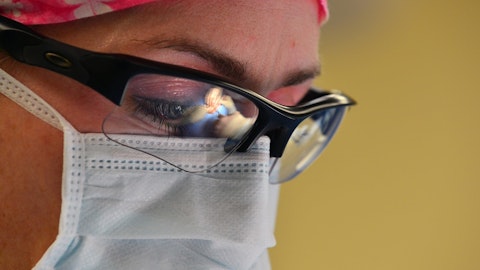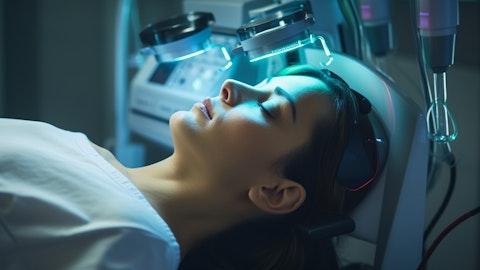We also review our benefits through co-branded media and Evolux, and it generally takes about 12 months for a new account to become meaningfully productive. And so that cadence is important to us because we want to ensure that each customer has the Evolus experience. And so we’ll continue to add new accounts as we receive them, but we’re limited by just our ability to run them through the proper steps that believe, lead to a productive customers. So that equally is important to us, of course, as it is to look at the volume of accounts that come in. As we’ve now entered the new year, it’s been what we expected. We saw very healthy trends in the back half of last year, I think you observed not just in our revenue acceleration, but you observed a broader market.
that reported that they had reported strong trends from consumer demand. We’re seeing similar trends carried through into the, call it, the first quarter of the year. So it’s a good year, off to a good start as we expected. Nothing unusual.
Serge Belanger: Maybe one last one. Regarding your targets for $700 million in sales by 2028, I think you’ve previously talked about expected breakdown between Jeuveau and Evolysse in the U.S. So maybe just talk about what we should expect for ex-U.S. contribution to that $700 million revenue target.
Sandra Beaver: Serge, I will be happy to take that. So as we look at the $700 million, we expect 10% to 15% of that revenue to come from OEM, call it, in the range of $100 million. where we then have the remainder coming from both the filler franchise and the Thomson franchise in the U.S. As I noted on the call, it’s a $10 billion market that we’ve got coverage in by the time you get out to 2028. And as David mentioned, about $1.8 billion of that market is the OUS market. So that still leaves us lots of opportunity to overperform that number. I think we’ve — it’s very clear that, that’s the low end of our long-range guidance. And I think that comes from our confidence in the performance of our products as well as the opportunity and the size of the opportunity in these markets across geographies and across the product lines.
Serge Belanger: Thank you.
Operator: And our next question comes from Uy Ear with Mizuho Securities. Please state your question.
Uy Ear: Hi guys thanks for taking my question and congrats on hitting non-GAAP profitability. So on the Restylane-L study, I was wondering if you guys can sort of talk a bit about maybe the differences or similarities in safety with respect either to bruising and swelling and/or any of the types of things that might have been notable. And I guess on the second question is — could you also kind of elaborate on the market with millennials in particular for Lift? Just curious to see how that’s sort of changing the — is it sort of a similar kind of, I guess — do they see sort of the similar kind of benefits that you see from Jeuveau because they’re not — I guess, historically, these products have sort of been using older patients. Thanks
Rui Avelar: I’ll take your first question, Uy. The — in terms of the rest of the AE profile, when you’re looking at them, they’re pretty similar. If anything, if I recall correctly, the — if you look at the AE trends, actually favorable Evolysse versus the Restylane product. In terms of the swelling, again, as an AE, it was pretty similar, again, seem to favor Evolysse. In terms of swallowing post procedure, which is slightly different, one of the pieces of feedback that we’ve gotten very consistently is one of the reasons why they seem to like injectors like the Evolysse product is. What you correct to is what you get? In other words, you don’t have to inject product and then take into consideration this product going to swell over time?
Or is to have to under correct or have to correct. The comment that we’re getting consistently from the investigators is just correct to your optimal correction and you’re done. You don’t have to take any additional swelling into consideration.
David Moatazedi: And then we, as far as the demographics that are getting injected with fillers, I think you’re right. First on average, fillers overall skew a bit older than neurotoxins. Now that being said, as you go a layer deeper, consumers that are younger coming in for filler treatments in the lips. And so lips seems to be the gateway for the younger generation. And then it works its way into other areas where as you move to the cheeks, it’s generally an older generation that’s getting treated further up in their cheek phone. And so the answer is it varies, which is why we have a full portfolio of products just as you see the market leaders do as well so that you’re treating different patient types. I think that gives us a unique opportunity.
In the end, the way we look at the filler business is a little different, which is, first, — we look at it by product, meaning we expect this lift product to be the most versatile. And just like Jeuveau is indicated in the Glabellar lines, it is often used outside of our indication and outside the Glabellar area to areas that are not approved like the forehead and the gross feet into all of the comments. The same applies with some of these fillers sellers like the Lift product, which is versatile, including the Restylane product, which is also considered a versatile filler wear. A patient may get injected in areas like lips and also the nasolabial folds and other areas. So I think there’s a lot more we need to learn about how we’ll position each of the brands and what that means for our consumer segmentation.
But in the end, the overlap between the customers actually injecting these fillers is nearly one-to-one with our toxin users. And so it gives us an opportunity to learn with our existing customers how best to do that.
Uy Ear: Do you foresee perhaps maybe going deeper or wider, I guess, into sort of the outside of the spas, I guess?




